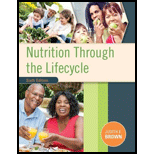
Nutrition Through the Life Cycle (MindTap Course List)
6th Edition
ISBN: 9781305628007
Author: Judith E. Brown
Publisher: Cengage Learning
expand_more
expand_more
format_list_bulleted
Concept explainers
Question
Chapter 2, Problem 27RQ
Summary Introduction
To examine: Whether the statement “Women who received WIC services from one pregnancy through to a subsequent pregnancy appear to gain more weight during the subsequent pregnancy than do women who receive WIC benefits during pregnancy only” is true or false.
Introduction: Women, Infants, and children (WIC) program is the special supplemental nutrition program for women, infants, and children. It provides supplemental foods, free health care assessment, and nutrition education to low income pregnant, breastfeeding and postpartum women, infants, and children up to age five who are at the nutritional risk.
Expert Solution & Answer
Want to see the full answer?
Check out a sample textbook solution
Chapter 2 Solutions
Nutrition Through the Life Cycle (MindTap Course List)
Ch. 2 - Prob. 1.1CSCh. 2 - Prob. 1.2CSCh. 2 - Prob. 1.3CSCh. 2 - Prob. 1.4CSCh. 2 - Prob. 1.5CSCh. 2 - Prob. 2.1CSCh. 2 - Prob. 2.2CSCh. 2 - Prob. 2.3CSCh. 2 - Prob. 2.4CSCh. 2 - Prob. 1RQ
Ch. 2 - Prob. 2RQCh. 2 - Prob. 3RQCh. 2 - Prob. 4RQCh. 2 - Match the term listed in Column A with its...Ch. 2 - Prob. 6RQCh. 2 - Match the term listed in Column A with its...Ch. 2 - Prob. 8RQCh. 2 - Match the term listed in Column A with its...Ch. 2 - Prob. 10RQCh. 2 - Match the term listed in Column A with its...Ch. 2 - Match the term listed in Column A with its...Ch. 2 - Match the term listed in Column A with its...Ch. 2 - Prob. 14RQCh. 2 - Prob. 15RQCh. 2 - Prob. 16RQCh. 2 - ________ Although the incidence of neural tube...Ch. 2 - Prob. 18RQCh. 2 - Prob. 19RQCh. 2 - Prob. 20RQCh. 2 - Prob. 21RQCh. 2 - Prob. 22RQCh. 2 - Prob. 23RQCh. 2 - Prob. 24RQCh. 2 - Prob. 25RQCh. 2 - Prob. 26RQCh. 2 - Prob. 27RQCh. 2 - Prob. 28RQCh. 2 - Prob. 29RQ
Knowledge Booster
Learn more about
Need a deep-dive on the concept behind this application? Look no further. Learn more about this topic, health-nutrition and related others by exploring similar questions and additional content below.Recommended textbooks for you
 Nutrition Through The Life CycleHealth & NutritionISBN:9781337919333Author:Brown, Judith E.Publisher:Cengage Learning,Essentials Health Info Management Principles/Prac...Health & NutritionISBN:9780357191651Author:BowiePublisher:Cengage
Nutrition Through The Life CycleHealth & NutritionISBN:9781337919333Author:Brown, Judith E.Publisher:Cengage Learning,Essentials Health Info Management Principles/Prac...Health & NutritionISBN:9780357191651Author:BowiePublisher:Cengage Nutrition Through the Life Cycle (MindTap Course ...Health & NutritionISBN:9781305628007Author:Judith E. BrownPublisher:Cengage LearningUnderstanding Health Insurance: A Guide to Billin...Health & NutritionISBN:9781337679480Author:GREENPublisher:Cengage
Nutrition Through the Life Cycle (MindTap Course ...Health & NutritionISBN:9781305628007Author:Judith E. BrownPublisher:Cengage LearningUnderstanding Health Insurance: A Guide to Billin...Health & NutritionISBN:9781337679480Author:GREENPublisher:Cengage

Nutrition Through The Life Cycle
Health & Nutrition
ISBN:9781337919333
Author:Brown, Judith E.
Publisher:Cengage Learning,

Essentials Health Info Management Principles/Prac...
Health & Nutrition
ISBN:9780357191651
Author:Bowie
Publisher:Cengage


Nutrition Through the Life Cycle (MindTap Course ...
Health & Nutrition
ISBN:9781305628007
Author:Judith E. Brown
Publisher:Cengage Learning


Understanding Health Insurance: A Guide to Billin...
Health & Nutrition
ISBN:9781337679480
Author:GREEN
Publisher:Cengage